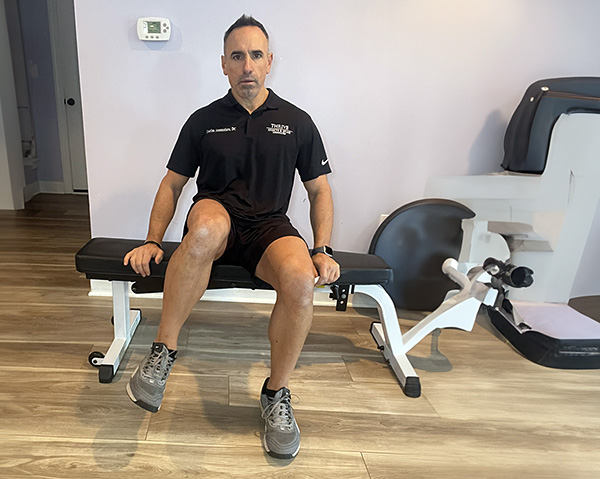Some doctors thrive in a personality-based clinic and have a loyal following no matter what services or equipment they offer, but for most chiropractic offices who are trying to grow and expand, new equipment purchases help us stay relevant and continue to service our client base in the best, most up-to-date manner possible. So, regarding equipment purchasing: should you lease, get a bank loan, or pay cash?
Biomechanical Bridge: Connecting Hip Mobility to Low Back Health
- The correlation between limited hip internal rotation and low back pain is elucidated in many recent studies.
- To correct limited hip rotation, it is best to use a combination of hip joint mobilization, stretches, and strengthening exercises.
- By incorporating hip internal rotation assessment into evaluations, chiropractors can develop more effective and comprehensive treatment strategies.
Low back pain (LBP) is the second most common symptom-related reason for clinician visits in the United States (skin disorders is #1) and the most common indication for chiropractic care. In fact, up to 84% of the U.S. population reports LBP symptoms at some point during their lifetime. However, the etiology of LBP is not well-understood considering the evidence that people without LBP have structural changes and many LBP patients have no structural changes on imaging studies of the lumbar spine.
Long and colleagues performed a standardized mechanical assessment on 312 patients with LBP, with and without sciatica. They were able to successfully subgroup 230 (74%) of these patients; however, 26% of the patients did not fit into a subgroup.1 So, the question remains: How do health care providers best assess people with LBP in order to develop a specific and successful treatment recommendation? Might we look beyond the spinal column for the source of, or contributor to, pain and loss of function?
Research now shows that limited hip internal rotation can significantly contribute to low back pain. This may be caused by hip joint variants, but more commonly by trauma causing adhesion of the hip joint capsule or even prolonged sitting, which overactivates the hip flexors and abductors, and underactivates the hip extensors and adductors.
Let’s explore the relationship between hip mobility and lower back health, highlighting how restricted hip internal rotation can lead to various issues in the lumbar spine.
Biomechanics
Hip internal rotation plays a crucial role in normal gait, balance, and functional movement. When this range of motion becomes restricted, it forces compensation in other parts of the body, particularly the lumbar spine.2 This compensation can lead to several problems:
- Lumbar Overrotation: Reduced hip mobility causes the lumbar spine to overrotate during everyday movements, increasing pressure on intervertebral discs, muscles, and ligaments.
- Pelvic Dysfunction: Limited internal rotation, especially when asymmetrical, can cause pelvic imbalances that pull the lower spine into abnormal positions.
- Altered Biomechanics: The lack of hip internal rotation changes overall movement patterns, altering the natural biomechanics of the spine and pelvis.
What Does the Research Say?
The correlation between limited hip internal rotation and low back pain is elucidated in many recent studies. Sadhegisani, et al.,2 reported that asymmetrical and limited hip internal rotation ROM were common findings in patients with LBP. Reduced and asymmetrical total hip rotation was also observed in patients with LBP. However, none of the studies explicitly reported limited hip external rotation ROM; proving that not all hip rotation ROM affects low back pain, just internal rotation.
Ellison, et al., reported that deficits in hip internal rotation are related to both LBP and sacroiliac joint pain.3 Another study found that patients with low back pain and positive hip findings such as a positive anterior hip impingement test, FABER test, and/or log-roll test, have more pain and worse function compared to those without positive hip findings.
Research has also demonstrated that a loss of hip internal rotation can prevent the pelvis from rotating properly over the stance limb during gait, affecting the coupling mechanics of the sacrum and lumbar spine.4
What Causes Hip-Related Low Back Pain?
The development of low back pain due to limited hip internal rotation can occur through several mechanisms, such as compensatory spinal motion, pelvic and lumbar muscle imbalances, and repetitive stress syndrome.2 When hip rotation is limited, the spine may compensate by rotating, extending, or flexing more than it should. Restricted hip mobility can lead to muscle imbalances through overactivity and tightness related to muscles such as the piriformis, potentially compressing the sciatic nerve.
Repetitive-stress injuries also come into play. Even small amounts of repeated rotation in the spine, compensating for lack of hip mobility, can produce microscopic injuries to spinal structures over time.

How to Make the Diagnosis
Limitations in hip internal rotation can be diagnosed through several assessments, such as:
Seated Test: The patient sits on the edge of a treatment table with feet dangling, knees and hips flexed to 90 degrees. They are asked to keep their knees together while moving their ankles apart. The chiropractor may apply overpressure to add a passive component.
Prone Test: With knees together and flexed to 90 degrees, the ankles are allowed to fall apart. Overpressure can be applied for a passive component.

Gait Observation: While assessing gait, you may notice movement compensations such as overpronation of feet, knee valgus, reduced step length, external rotation of the foot during stance phase, or increased lumbar and knee extension.
How to Correct
To correct limited hip rotation, it is best to use a combination of hip joint mobilization, stretches, and strengthening exercises. Joint play assessment with mobilization in the direction of limited movement through manipulation and hip scouring techniques, as well as soft-tissue mobilization to the ipsilateral psoas, glute medius and piriformis muscles, are a great place to start. Follow with hip stretching and strengthening exercises, such as:
- Twisted Legs Hip Internal Rotation: Have your patient sit on the ground, letting both knees fall to one side, and placing the top foot on the opposite knee. 10 reps per side.
- Seated Hip Internal Rotation: Patient sits with knees at 90 degrees, flexes one foot, and turns the inner thigh toward the ground. 20-30 reps per side.
- 90/90 Hip IR Lift-Off: In a 90/90 position, patient lifts the back leg while focusing on internal rotation; then holds each side for 15 seconds and performs three per side (more of a stretch).
- Step Across: In a staggered stance, patient steps across the midline with the back foot while keeping the front leg still. Repeat 20 times.
- Band Lateral Distraction IR Rockback: Seated patient uses a band for lateral distraction while rocking and maintaining internal rotation of the hip against resistance, focusing on keeping a flat back. 10 reps per leg.
- Swivel Chair (not pictured): This is a great stretch your patients can do right in their office at home / work. Patient places knee on a swivel chair and swings the foot outward, keeping the pelvis still. Repeat 20 times.

By incorporating hip internal rotation assessment into evaluations, chiropractors can develop more effective and comprehensive treatment strategies that address both spinal and hip dysfunction as a cause of low back pain, leading to improved patient outcomes and long-lasting relief.
References
- Long ADR, et al. Does it matter which exercise? A randomized control trial of exercise for low back pain. Spine, 2004 Dec 1;29(23):2593-602.
- Sadhegisani M, et al. Correlation between hip ROM impairment and low back pain: a literature review. Ortop Traumatol Rehabil, 2015 Oct;17(5):455-623.
- Ellison JB, et al. Patterns of hip rotation ROM: a comparison between healthy subjects and patients with LBP. Phys Ther, 1990 Sep;70(9):537-41.
- Yoon J-Y, Moon SW. Impacts of asymmetric hip rotation angle on gait biomechanics in patients with knee osteoarthritis. Knee Surg Relat Res, 2024 Jul 14;36(1):23.



